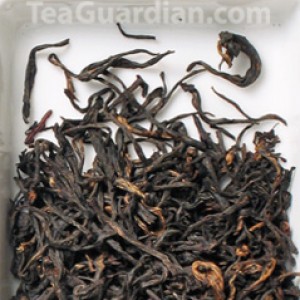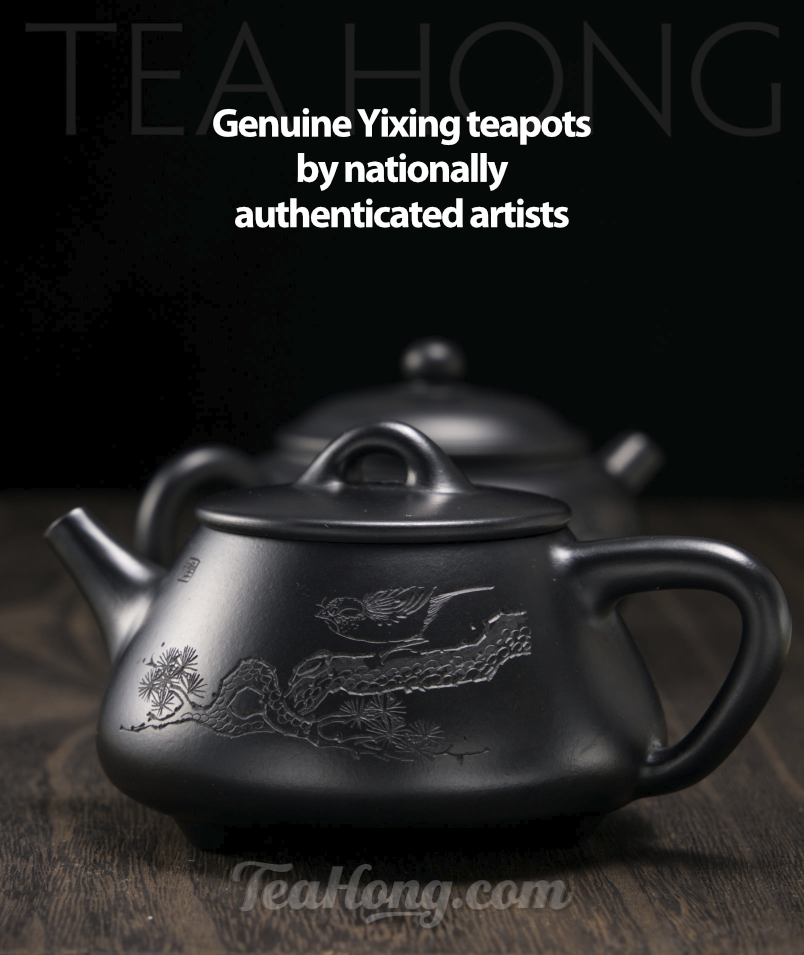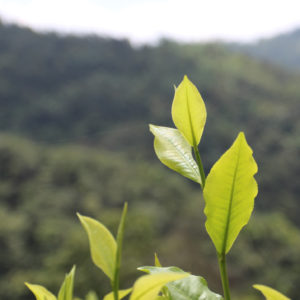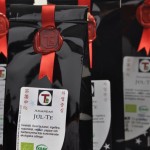Minhong Gongfu: Fujian Black Teas
- Zhenghe Gongfu, having the roundest and longest body in terms of taste, is made with the same cultivar for the white tea Zhenghe Bai Mudan (aka Zhenghe White Peony), which is also reputable for its body. Finer selections consists usually of a high percentage of pekoe, giving the black tea a golden appearance. The larger, softer leaves also distinguishes its look, but it is not to be mistaken as Dianhongs (aka Yunnan blacks), which leaves are coarser and harder, and tastes differently. This selection in the photo is of a special grade 1, with quite a lot of golden tips and optimum fire finish. Notice that both the leaves and the tips are tightly twisted and there is a slight glossiness to them. These characters differentiate zhenghe’s apperance from that of Dianhong.
- Bailin Gongfu: To the east of Zhenghe where Bai Mudan is made with the cultivar Fuding Dai’bai, a counterpart of Zhenghe Dai’bai, Bailin Gongfu is made. The taste is a little more floral, but shorter, and the body not as round. The appearance can be rather similar. This particular selection in the photo is a special grade 3, one step above grade 1. Notice the typical large and unwieldy tips.
- Tangyang Gongfu: To the west of Zhenghe and all the way to, and including Wuyi, are numerous regions that were some of the first production bases for export teas. Tanyang Gongfu is produced here with cultivars totally different from the Dai’bai strands. The traditional Xiaozhong strands produce teas that are smooth, quite long and tinkling. Newer cultivars that are introduced from Yunnan, that is, strands from the Camellia assamica variety, produce teas that are stronger but less complex in taste. Perhaps for productivity reasons, the latter is now a lot more popularly used for producing Tanyang Gongfu. This selection here is a grade 2, and more than a year old. Newer ones looks glossier and taste freshers too.
Minhongs 閩紅 refers to the gongfu black teas produced in eastern Fujian, traditionally include Zhenghe (zhèng•hé) Gongfu, Bailin (bái•lín) Gongfu and Tanyang (tǎn•yáng) Gongfu 政和工夫、白琳工夫、坦洋工夫
Minghongs are perhaps the sweetest of all black teas, although they would not have the “strength” that Assam, Yunnan and Sri Lanka blacks have. The maltiness is also rather more floral than cereal. However, these are exactly their likable characters.
Historically, there are three major style of Fujian black teas, namely Tanyang, Bailin and Zhenghe. New developments have continued to take place in this area since the beginning of the 21st century and new varieties with shining qualities. These are discussed in separate articles.
origin
It is not clear whether black teas started in Fujian or Jiangxi, but Fujian definitely was a first key production base for black tea for export. The area around Wuyi was one of the first production region. Now all across the north to northeastern provincial border areas are producing black teas, alongside with greens, whites and oolongs, though some farms are specialized in at most two categories.
Fujian blacks was the taste that the West first known what black tea was and that turned England entirely into a tea drinking nation. <read more about the history of black teas>
Since the successful production of tea in Assam in the then British colony of India in the latter part of 19th century, allowing the British Empire almost total control of its tea price, black tea production in Fujian dwindled. Some farmers switched to other crops, some to oolongs and green teas, and some continued to produce for the tiny portion of the market.
Yet some others were pushed to raise their quality standard to target the regional Chinese population, in particular those in Hong Kong and other parts of southeast Asia. The oolong drinking tradition in these people naturally see the curly twigs as just yet another oolong and consume the black tea in the gongfu tea making approach. Born was the Gongfu black (aka Gongfu Hongcha) tradition. That is why unlike the black teas produced anywhere else, those from Fujian are tied particularly tightly with the consumption method.
Unluckily, the latter part of the 19th century and a large part of the 20th century had seen China in epic chaos and destructive social unrests. Tea production, in particular a fine and demanding one for finer teas, had been in an overall continued fall.
Gongfu blacks did not make a real come back until the 1980’s when producers’ self-initiative began to take over that of collective governance. Its popularity, and thereby competitiveness for quality and variety, picked up when the dynamics of the market was given an almost total free hand. The selections available now are perhaps unprecedented in history.
buying tips
Each of the three major styles used to have its own nuances but with the recent dynamic exchange of production techniques, labour, and horticulture, the differences are less staying with the region but rather with each individual production farm. Most farms even produce simultaneously with different styles. The most confusing factor being some wholesalers and even producers would label their products with whatever names seem to be popular at the time when they sell. A Tanyang Gongfu may therefore, be a very different product from one source to another, adding even more complexity to sourcing for the originally not-so-straightforward understanding of the tea variety.
Because of certain marketing efforts, Tanyang Gongfu in particular has seen a hike in price in the recent few years and I think the value is not so justified. For the same price, you may very well be getting a lot more quality in other Fujian black productions.
tasting notes
Fujian black teas are enjoyable as you would with any other black teas. However, because its unique character is not about strength, adding milk or sugar to cover the bitterness as in other teas is not going to give you a same tasting tea drink — there is no excessive bitterness needed to cover up and the milk or sugar will lower the taste character. However, if you choose to stick to the milk and sugar habit, smash some of the leaves before infusion so the liquor will be much stronger.
The variety shows their colour when enjoyed plain with the conventional or gongfu tea infusion approach.
health notes
It has been a myth that black teas carry more caffeine than green teas. The fact is, the caffeine content in your cup is related to a lot more elements than just the tea category. In a measuring method study published in Elsevier Science (1), scientists even found that amongst teas that one can get from a Chinatown teashop, their Fujian black sample had less caffeine than 3 other green tea samples.
Unfortunately, black teas have always been seen as one single entity in most researches. It is beyond my comprehension that the difference in the very nature of the leaves and production methods in the varieties of black teas has not been more frequently considered when the scientists produce their data.
Do click on to the caffeine page to read more about the topic if you are concerned or interested. The bottom line is, so far in our observation and reading, it seems likely that Fujian blacks are on average as a whole the lowest caffeine content in the black tea category. It is an option if you prefer black teas but want to minimize caffeine.














